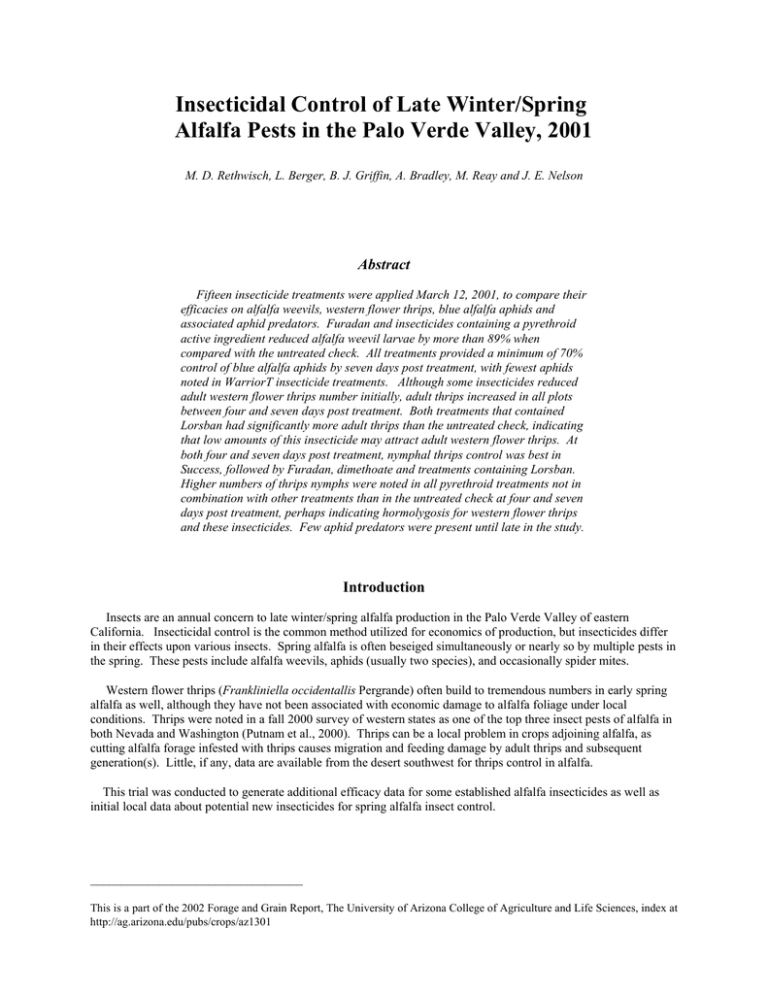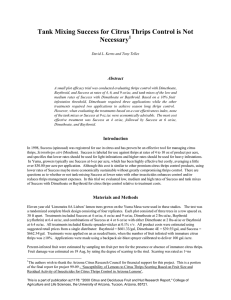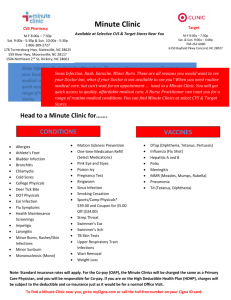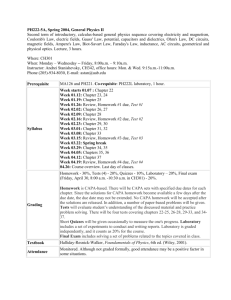Insecticidal Control of Late Winter/Spring Abstract
advertisement

Insecticidal Control of Late Winter/Spring Alfalfa Pests in the Palo Verde Valley, 2001 M. D. Rethwisch, L. Berger, B. J. Griffin, A. Bradley, M. Reay and J. E. Nelson Abstract Fifteen insecticide treatments were applied March 12, 2001, to compare their efficacies on alfalfa weevils, western flower thrips, blue alfalfa aphids and associated aphid predators. Furadan and insecticides containing a pyrethroid active ingredient reduced alfalfa weevil larvae by more than 89% when compared with the untreated check. All treatments provided a minimum of 70% control of blue alfalfa aphids by seven days post treatment, with fewest aphids noted in WarriorT insecticide treatments. Although some insecticides reduced adult western flower thrips number initially, adult thrips increased in all plots between four and seven days post treatment. Both treatments that contained Lorsban had significantly more adult thrips than the untreated check, indicating that low amounts of this insecticide may attract adult western flower thrips. At both four and seven days post treatment, nymphal thrips control was best in Success, followed by Furadan, dimethoate and treatments containing Lorsban. Higher numbers of thrips nymphs were noted in all pyrethroid treatments not in combination with other treatments than in the untreated check at four and seven days post treatment, perhaps indicating hormolygosis for western flower thrips and these insecticides. Few aphid predators were present until late in the study. Introduction Insects are an annual concern to late winter/spring alfalfa production in the Palo Verde Valley of eastern California. Insecticidal control is the common method utilized for economics of production, but insecticides differ in their effects upon various insects. Spring alfalfa is often beseiged simultaneously or nearly so by multiple pests in the spring. These pests include alfalfa weevils, aphids (usually two species), and occasionally spider mites. Western flower thrips (Frankliniella occidentallis Pergrande) often build to tremendous numbers in early spring alfalfa as well, although they have not been associated with economic damage to alfalfa foliage under local conditions. Thrips were noted in a fall 2000 survey of western states as one of the top three insect pests of alfalfa in both Nevada and Washington (Putnam et al., 2000). Thrips can be a local problem in crops adjoining alfalfa, as cutting alfalfa forage infested with thrips causes migration and feeding damage by adult thrips and subsequent generation(s). Little, if any, data are available from the desert southwest for thrips control in alfalfa. This trial was conducted to generate additional efficacy data for some established alfalfa insecticides as well as initial local data about potential new insecticides for spring alfalfa insect control. __________________________________ This is a part of the 2002 Forage and Grain Report, The University of Arizona College of Agriculture and Life Sciences, index at http://ag.arizona.edu/pubs/crops/az1301 Methods and Materials Treatments were applied the morning of March 12, 2001 with a back pack CO2 sprayer calibrated to apply 22.1 gpa at 20 psi with four T-Jet 8002VS nozzle tips. Plots were 6' wide x 25' long. Treatments were replicated four times, and all insecticide treatments had the surfactant R-11 (Wilbur-Ellis Co.) added at a rate of 1 oz./gal. of spray (0.78125%). Alfalfa was a new stand planted in early Nov. 200 (consisting of several varieties mixed together) that had not been previously harvested and was 20 inches tall at time of application. Plots were sampled one, four, seven, 14 and 21 days post treatment with a 15 inch diameter sweep net. Ten three foot sweeps were made in each plot. Net contents were then transferred to plastic containers and frozen for subsequent insect separation and counting. Numbers of alfalfa weevils and blue alfalfa aphids were recorded for all five sample dates, but thrips numbers were recorded for just the first three (1,4 and 7 days post treatment) samplings. Other insects and predators (spiders) were also counted when present and analyses conducted when sufficient numbers permitted, with most beneficial insects not present until 14 days post treatment. All data were analyzed utilizing Statgraphics Plus for Windows (Manugistics, Inc.), and separations of treatment means for the various insects was accomplished using a Fishers least significant difference. Results Alfalfa Weevils Alfalfa weevil larvae peaked during the experiment with highest numbers recorded in the four day post treatment sample (Table 1). Larval weevil numbers were high for the first week following treatment, providing excellent confidence in experimental findings, but declined rapidly thereafter. All treatments significantly reduced alfalfa weevil larval by one day post treatment, but reductions noted ranged from approximately 50% control (Calypso, Success @ 4 oz + Dimethoate) to approximately 90% control (all pyrethroid treatments and Furadan). Success used as 6 oz/acre (+ Dimethoate) provided about 75% control, slightly better than did Dimethoate by itself (68% control), which was very similar to Lorsban 4E at one pt/acre at this sample date. By four days post treatment weevil control increased (on a percentage basis) for almost all insecticides with the exception of Calypso and Dimethoate, which both still had control levels equivalent to that of one day post treatment. Treatments containing a pyrethroid insecticide and the Furadan 4F treatment provided >89% control. Control of alfalfa weevil larvae from the Success treatments ranged from 83-88% at this sample date, with Lorsban 4E at the 1 pt/acre rate provided 82% control. At seven days post treatment, percentage control was very similar to that of four days post treatment, although a slight decrease was noted for the Success treatments and the Lorsban treatment. Control noted in the Calypso treatment was less than 40%, but greater than 96% control was noted from a number of pyrethriod treatments as well as the rate of Furadan 4F utilized. Dimethoate continued to provide about 66% control of weevil larvae. Weevil control at 14 days post treatment lessened compared with that of seven days post treatment for most treatments, as weevils increased slighly in numbers in most plots while declining in the untreated check (Figure 1). Data from 21 days post treatment found weevils numbers to be very similar in all treatments. Blue Alfalfa Aphids Aphids in this experiment were almost entirely blue alfalfa aphids (Acyrthosiphon kondoi Shinji) with an occasional pea aphid (less than 0.5%). Aphids increased during the experiment, peaking in the untreated check at 7 days post treatment (Table 2), with substantial population reduction thereafter. At one day post treatment both rates of F0570 had the fewest aphids. Treatments containing Dimethoate also provided an average of 82% aphid reduction, followed by Furadan and the high rate (2.4 oz/acre) of Baythroid. A significantly higher population was noted in the Calypso plus Baythoid 2 treatment than was noted in either Calypso or Baythoid at same rate by themselves, perhaps indicating some antagonism. All treatments, with the exception of the Baythroid + Calypso treatment, provided 50% control at one day post treatment. At four days post treatment aphid numbers increased in some treatments, decreased in others, and remained almost the same in a few other treatments. Aphid numbers decreased in both WarriorT treatments, the Baythroid + Lorsban, the high rate of Baythroid, and the Baythroid + Calypso treatments. Large increases (doubling or greater) of aphid numbers were noted in both F0570 treatments. A large increase in aphid numbers was also noted in the Calypso treatment, and this increase was actually larger in number than those in the F0570 treatments. The 2.4 oz/acre rate of Baythroid 2 and the 6 oz/acre rate of Success + dimethoate were the only two treatments that averaged less than 100 aphids in the 10 sweep samples at four days post treatment. Aphid numbers decreased in all insecticide treatments between four and seven days post treatment, although numbers of aphids remained almost identical in the untreated check. Fewest aphids were noted in both WarriorT treatments (>93.8% control), followed by the 4 oz/acre rate of F0570 and the Baythroid + Lorsban treatment (both 92.8% control); highest aphid populations in treatments were noted in the Furadan (84.5% control) and Calypso (74.5% control) treatments at seven days post treatment. At fourteen days post treatment aphid numbers had decreased in the untreated check by about 45%, while increasing in all insecticide treatments. Both WarriorT treatments and both treatments containing Lorsban kept aphid numbers from exceeding 100/ten sweeps on this sample date. Average control in these four insecticide treatments was 77%. Aphid numbers in all insecticide treatments exceeded that of the untreated check at 21 days post treatment. Western Flower Thrips Adults All chemistries applied reduced adult western flower thrips at one day post treatment (Table 3), although a wide range of reductions was noted. Fewest adult thrips were noted in the high (4 oz/acre) rate of F0570 which reduced thrips by 77%, followed by Furadan and dimethoate (both 73.5% reduction). Least reduction was noted in the high rates of Baythroid tested (28-34% control) at one day post treatment. At four days post treatment differences in adult thrips numbers compared with the untreated check were not as readily noticable. Rate responses for WarriorT, Baythroid and Success (the higher the rate, the fewer adult thrips) were noted. Highest numbers of adult thrips were present in plots that had been treated with Lorsban (alone or in combination) and the low rate (3.0 oz/acre) of WarriorT. Adult thrips increased in all plots between four and seven days post treatment (Table 3). Both treatments that contained Lorsban had significantly more adult thrips than the untreated check, indicating that this treatment may attract adult western flower thrips. Means of adult western flower thrips in other treatements were not statistically different than the untreated check, although a range of adult flower thrips existed in the other treatements. The next highest numbers of western flower thrips adults (after treatments containing Lorsban) were noted in the low rates for WarriorT and Baythroid. Only dimethoate and the 6 oz/acre rate of Success+ dimethoate had fewer adult thrips than the untreated check on this sample date. Thrips numbers were not obtained for 14 and 21 days post treatment. Western Flower Thrips Nymphs Western flower thrips nymphs were abundant through the seven days post treatment that samples were collected. At one day post treatment, numbers of nymphs were reduced at least 70% in only 5 treatments: both rates of Success + dimethoate, dimethoate alone, Lorsban (16 oz/acre rate) and Furadan. Rate responses were noted in nymph reduction at one day post treatment for F0570. Baythoid + Lorsban had fewer thrips nymphs than did the any other Baythroid treatment. Treatments containing Calypso had fewer thrips than the Baythoid alone at various rates. Numbers of nymphs increased in most treatments between one and four days post application, although the untreated check declined slightly. This slight reduction is thought due to interaction with weevils and aphids and lack of control in these plots. Further nymph reduction was noted between four and seven days post treatment. The only treatments in which nymphs numbers were reduced from one to four days post treatment were both rates of Success, and Furadan. These three treatments provided a range of 78.6% control (Furadan) to 89.4% control (6 oz./acre rate of Success + dimethoate). At both four and seven days post treatment, nymphal thrips control was best in Success, followed by Furadan, then dimethoate and treatments containing Lorsban, which significantly reduced thrips compared with most other treatments. Rate responses were noted for Success, Baythroid, WarriorT, and F0570, with the higher rates of each of these chemistries having fewer thrips nymphs that the lower rates tested. Higher numbers of thrips nymphs were noted in all pyrethroid treatments (not in combination with other treatments) than in the untreated check at four and seven days post treatment, perhaps indicating hormolygosis for western flower thrips and these insecticides. Calypso provided better thrips control than the pyrethroids tested, but not as good as non-pyrethoids in this trial on these sample dates. Beneficial Insects Beneficial insects consisted primarily of lady beetles (both the convergent ladybeetle Hippodamia convergens and the sevenspotted lady beetle Coccinella septempuctata) and syrphid flies. Populations of these species were not present in any numbers until 14 days post treatment. Ladybeetle larvae were more numerous than lady beetle adults at both 14 and 21 days post treatment (Table 5) and were more prevalent than were syrphid flies (Table 6). Little difference existed in numbers of adult beetles, but differences were noted in larval numbers, especially at 21 days post treatment. Fewest beetle larvae were noted in the WarriorT treatments, but these treatments also had fewer blue alfalfa aphids at 7 and 14 days post treatment. Treatments with higher numbers of ladybeetle larvae than the check at 21 days post treatment were the low (4 oz./acre) rate of Success + dimethoate, dimethoate, and Calypso. The reason for these increases is unclear, but may be indicative of the 'soft' aspect of certain of these chemistries. Syrphid fly numbers were very low, but highest numbers of larvae were noted at 21 days post treatment in the untreated check. Larval numbers were almost non-existant in any treatment at 14 days post application. Adults were more numerous than larvae at both 14 and 21 days post treatment. Some spiders and rove beetles were present at the beginning of this study. Means of these arthropods were not significantly different than the untreated check at one day post treatment however. Literature Cited Putnam., D., J. Brummer, D. Cash, A. Gray, T. Griggs, M. Ottman, I. Ray, W. Riggs, M. Smith, G. Shewmaker, and R. Todd. 2000. The importance of western alfalfa production. Pp. 1-9. In Proc. 29th National Alfalfa Symposium. 251 pp. Table 1. Mean number of alfalfa weevil larvae per 10 three foot sweeps at one, four, seven, 14 and 21 days after treatment on March 12, 2001, Blythe, CA. Rate/acre Treatment (lbs ai/acre) Success 2 + 4 oz (0.0625) Dimethoate 400 16 oz (0.5) Success 2 + 6 oz (0.09375) Dimethoate 400 16 oz (0.5) 1 18.75 d 4 9.75ab Days post treatment 7 14 13.5 bc 5.25ab 9.00abc 7.00a 3.50ab 4.25 b Dimethoate 400 16 oz (0.5) 12.50 bcd 19.5 bc 17.0 c 11.00 cd 3.0 ab Lorsban 4E 16 oz (0.5) 12.75 bcd 10.5ab 11.25abc 7.50 bc 1.75ab Baythroid 2 + Lorsban 4E 2 oz (0.03125) 8 oz (0.25) 3.75ab 6.25a 0.50a 2.00a 1.00a Baythroid 2 1.6 oz (0.025) 5.75ab 0.75a 1.75a 3.25ab 2.00ab Baythroid 2 2.4 oz (0.0375) 3.25ab 1.00a 0.50a 4.25ab 2.00ab Baythroid20 WP 2.5 oz (0.03125) 2.75a 2.25a 2.75ab 2.75a 0.75a Baythroid 2 + Calypso 4SC 1.6 oz (0.025) 1.5 oz (0.047) 5.75ab 4.25a 4.25ab 4.50ab 2.00ab Calypso4SC 1.5 oz (0.047) 17.50 cd 29.25 c 30.25 d 11.50 cd WarriorT 1E 3 oz (0.025) 5.25ab 2.75a 0.50a 3.75ab 2.50ab WarriorT 1E 3.84 oz (0.03) 5.50ab 1.25a 0.75a 2.50a 2.00ab F0570 0.8E 4 oz (0.025) 3.50ab 2.75a 2.00a 4.75ab 2.00ab F0570 0.8 E 2.7 oz (0.0167) 3.75ab 3.00a 2.75ab 2.50a 1.00a Furadan 4F 16 oz (0.5) 4.00ab 4.00a 0.50a 3.25ab 2.75ab Untreated Check ------ 39.00 e 57.75 d 8.0abc 21 4.25 b 50.0 e 13.0 d Means in columns followed by the same letter are not statistically different at the P<0.05 level of significance (Fishers LSD test). 2.75ab 1.75ab Table 2. Mean number of blue alfalfa aphids per 10 three foot sweeps at one, four, seven, 14 and 21 days after treatment on March 12, 2001, Blythe, CA. Treatment Rate/acre (lbs ai/acre) 1 4 Days post treatment 7 14 21 Success 2 + 4 oz (0.0625) Dimethoate 400 16 oz (0.5) 64.5a 118.75ab 66.5 a 172.0 a 188.5abc Success 2 + 6 oz (0.09375) Dimethoate 400 16 oz (0.5) 94.0a 92.25a 60.75a 105.75a 250.0 bc Dimethoate 400 16 oz (0.5) 73.25a 120.75ab 78.0 ab 110.5 a 114.5a Lorsban 4E 16 oz (0.5) 162.75ab 200.25ab 82.0 ab 98.25a 85.5a Baythroid 2 + Lorsban 4E 2 oz (0.03125) 8 oz (0.25) 147.00ab 129.75ab 47.5 a 74.25a 102.25a Baythroid 2 1.6 oz (0.025) 113.50a 128.75ab 86.75ab 158.25a 184.0 abc Baythroid 2 2.4 oz (0.0375) 88.25a 79.50a 57.5 a 120.5 a 158.0 abc Baythroid20 WP 2.5 oz (0.03125) 154.75ab 121.75ab 66.0 a 146.25a 262.25 c Baythroid 2 + Calypso 4SC 1.6 oz (0.025) 1.5 oz (0.047) 301.75 bc 183.00ab 96.5 ab 141.75a 138.0 abc Calypso 4SC 1.5 oz (0.047) 162.25ab 283.25 b 167.75 b 300.0 b 72.25a WarriorT 1E 3 oz (0.025) 139.5ab 121.00ab 40.5 a 69.75a 98.75a WarriorT 1E 3.84 oz (0.03) 182.5ab 130.00ab 31.0 a 87.5 a 65.0a F0570 0.8E 4 oz (0.025) 53.50a 109.75a 47.5 a 150.0 a 134.0ab F0570 0.8E 2.7 oz (0.0167) 56.25a 140.50ab 59.0 a 144.0 a 137.0ab Furadan 4F 16 oz (0.5) 87.50a 135.50ab 102.0 ab 102.25a 113.5a 432.00 c 655.25 c 660.0 c 361.5 b 65.0a Untreated Check ------ Means in columns followed by the same letter are not statistically different at the P<0.05 level of significance (Fishers LSD test). Table 3. Mean number of western flower thrips adults per 10 three foot sweeps at one, four, and seven days after treatment on March 12, 2001, Blythe, CA. Treatment Rate/acre (lbs ai/acre) 1 Days post treatment 4 7 Success 2 + 4 oz (0.0625) Dimethoate 400 16 oz (0.5) 11.75abc 17.50ab 35.25ab Success 2 + 6 oz (0.09375) Dimethoate 400 16 oz (0.5) 16.00abcd 14.75ab 29.50a 7.25ab 15.75ab 26.50a 11.75abc 33.75 c 62.25 bc Dimethoate 400 16 oz (0.5) Lorsban 4E 16 oz (0.5) Baythroid 2 + Lorsban 4E 2 oz (0.03125) 8 oz (0.25) 9.25abc 25.75 bc 79.50 c Baythroid 2 1.6 oz (0.025) 12.09abc 17.25ab 51.25ab Baythroid 2 2.4 oz (0.0375) 18.00 bcd 22.00abc 45.25ab 19.75 cd 18.52ab 34.50ab Baythroid20 WP 2.5 oz (0.03125) Baythroid 2 + Calypso 4SC 1.6 oz (0.025) 1.5 oz (0.047) 8.50ab 11.50a 44.75ab Calypso 4SC 1.5 oz (0.047) 13.75abc 14.50ab 31.25a WarriorT 1E 3 oz (0.025) 12.50abc 32.25 c 48.25ab WarriorT 1E 3.84 oz (0.03) 15.00abc 12.75a 34.50a F0570 0.8E 4 oz (0.025) 6.25a 18.00ab 36.00ab F0570 0.8E 2.7 oz (0.0167) 13.25abc 17.00ab 41.25ab Furadan 4F 16 oz (0.5) 7.25ab 17.25ab 42.25ab 27.42 d 18.75ab 31.75a Untreated Check ------ Means in columns followed by the same letter are not statistically different at the P<0.05 level of significance (Fishers LSD test). Table 4. Mean number of western flower thrips nymphs per 10 three foot sweeps at one, four, and seven days after treatment on March 12, 2001, Blythe, CA. Treatment Rate/acre (lbs ai/acre) Days post treatment 4 1 7 Success 2 + 4 oz (0.0625) Dimethoate 400 16 oz (0.5) 64.50a 54.25a 27.00a Success 2 + 6 oz (0.09375) Dimethoate 400 16 oz (0.5) 108.50abc 42.25a 17.50a Dimethoate 400 16 oz (0.5) 77.00a 131.75abc 120.25abc Lorsban 4E 16 oz (0.5) 89.50ab 174.75abc 142.75a-d Baythroid 2 + Lorsban 4E 2 oz (0.03125) 8 oz (0.25) 180.75abc 187.75abc 184.75 bcd Baythroid 2 1.6 oz (0.025) 258.66 bcd 442.25 de 431.0 g Baythroid 2 2.4 oz (0.0375) 253.75 bcd 320.50 cde 319.25 efg Baythroid20 WP 2.5 oz (0.03125) 263.25 cd 492.50 315.0 efg Baythroid 2 + Calypso 4SC 1.6 oz (0.025) 1.5 oz (0.047) 214.75abc 257.75 bcd 224.75 c-f Calypso 4SC 1.5 oz (0.047) 168.50abc 294.75 cd 224.25 c-f WarriorT 1E 3 oz (0.025) 142.25abc 452.25 de 323.0 fg WarriorT 1E 3.84 oz (0.03) 268.5 cd 306.00 cde 220.0 c-f F0570 0.8E 4 oz (0.025) 197.25abc 324.00 cde 235.75 c-f F0570 0.8E 2.7 oz (0.0167) 221.75abc 405.75 257.25 def Furadan 4F 16 oz (0.5) 105.00abc Untreated Check ------ 430.33 d e de 85.00ab 81.0ab 397.75 de 192.5 b-e Means in columns followed by the same letter are not statistically different at the P<0.05 level of significance (Fishers LSD test). Table 5. Mean number of adult and larval ladybird beetles per 10 three foot sweeps at 14 and 21 days after treatment on March 12, 2001, Blythe, CA. Adults Treatment Rate/acre (lbs ai/acre) Larvae Days post treatment 14 14 21 Success 2 + 4 oz (0.0625) Dimethoate 400 16 oz (0.5) 0.00a 0.00a 1.75ab 8.75 Success 2 + 6 oz (0.09375) Dimethoate 400 16 oz (0.5) 0.50 b 0.00a 1.75ab 5.25 bcde Dimethoate 400 16 oz (0.5) 0.00a 0.00a 1.50ab 6.50 Lorsban 4E 16 oz (0.5) 0.00a 0.00a 1.25ab 3.50abcd Baythroid 2 + Lorsban 4E 2 oz (0.03125) 8 oz (0.25) 0.00a 0.25ab 0.50a 1.75abc Baythroid 2 1.6 oz (0.025) 0.25ab 0.25ab 1.75ab 3.75abcd Baythroid 2 2.4 oz (0.0375) 0.00a 1.00 c 1.75ab 4.25abcd Baythroid20 WP 2.5 oz (0.03125) 0.25ab 0.75 bc 1.75ab 4.25abcd Baythroid 2 + Calypso 4SC 1.6 oz (0.025) 1.5 oz (0.047) 0.25ab 0.50abc 2.25ab 4.00abce Calypso 4SC 1.5 oz (0.047) 0.00a 0.00a 3.50 bc 6.50 de WarriorT 1E 3 oz (0.025) 0.00a 0.25a 1.25ab 1.25ab WarriorT 1E 3.84 oz (0.03) 0.00a 0.00a 1.50ab 0.75a F0570 0.8E 4 oz (0.025) 0.00a 0.00a 1.25ab 1.75abc F0570 0.8E 2.7 oz (0.0167) 0.00a 0.25ab 0.50a 1.50ab Furadan 4F 16 oz (0.5) 0.00a 0.00a 1.75ab 3.50abcd 0.00a 0.25ab 5.50 c 6.00 cde Untreated Check ------ 21 Means in columns followed by the same letter are not statistically different at the P<0.05 level of significance (Fishers LSD test). e de Table 6. Mean number of adult and larval syrphid flies per 10 three foot sweeps at 14 and 21 days after treatment on March 12, 2001, Blythe, CA. Adults Treatment Rate/acre (lbs ai/acre) 14 Larvae Days post treatment 21 14 21 Success 2 + 4 oz (0.0625) Dimethoate 400 16 oz (0.5) 0.50ab 1.00ab 0.00a 0.00a Success 2 + 6 oz (0.09375) Dimethoate 400 16 oz (0.5) 0.50ab 1.50ab 0.00a 0.75ab Dimethoate 400 16 oz (0.5) 0.75ab 1.50ab 0.00a 1.00ab Lorsban 4E 16 oz (0.5) 0.25ab 1.50ab 0.00a 1.25ab Baythroid 2 + Lorsban 4E 2 oz (0.03125) 8 oz (0.25) 0.75ab 1.75ab 0.00a 1.00ab Baythroid 2 1.6 oz (0.025) 0.25ab 1.25ab 0.00a 1.25ab Baythroid 2 2.4 oz (0.0375) 1.25 b 0.50a 0.00a 1.75 bc Baythroid20 WP 2.5 oz (0.03125) 0.25ab 1.25ab 0.00a 1.50abc Baythroid 2 + Calypso 4SC 1.6 oz (0.025) 1.5 oz (0.047) 1.00ab 1.25ab 0.00a 1.50abc Calypso 4SC 1.5 oz (0.047) 0.50ab 1.5ab 0.00a 2.00 bc WarriorT 1E 3 oz (0.025) 0.75ab 1.75ab 0.00a 1.00ab WarriorT 1E 3.84 oz (0.03) 1.25 b 0.75ab 0.00a 1.00ab F0570 0.8E 4 oz (0.025) 0.00a 0.75ab 0.00a 1.25ab F0570 0.8E 2.7 oz (0.0167) 0.75ab 2.25 b 0.00a 0.75ab Furadan 4F 16 oz (0.5) 0.25ab 1.75ab 0.00a 0.75ab 0.75ab 0.25a 0.50 b 3.00 c Untreated Check ------ Means in columns followed by the same letter are not statistically different at the P<0.05 level of significance (Fishers LSD test).





